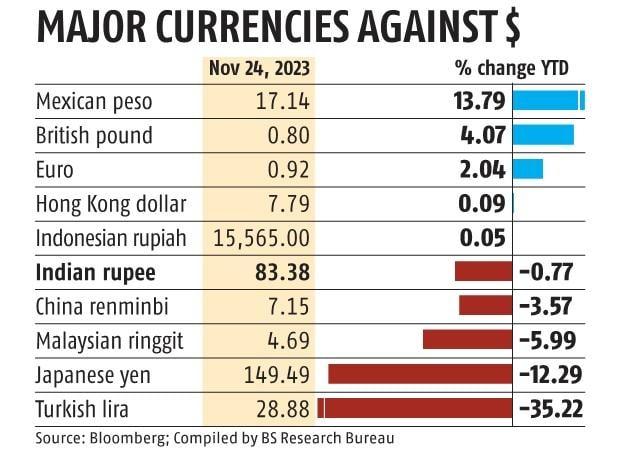The Indian rupee closed at a new low of 83.38 against the US dollar, marking a slight decline from the previous close of 83.34. This drop was attributed to increased dollar demand from oil companies and intervention by the Reserve Bank of India (RBI) to mitigate a steeper fall.
Factors Influencing Rupee’s Performance:
1. Dollar Demand from Oil Companies: The primary factor contributing to the rupee’s decline was the heightened demand for dollars from oil companies. This demand, coupled with RBI interventions, played a crucial role in shaping the day’s forex market dynamics.
2. RBI Intervention: The Reserve Bank of India actively intervened to stabilize the rupee, preventing a more significant depreciation. Despite these efforts, the currency closed at a new low, indicating the challenges faced by the central bank in managing the forex market.

Regional Currency Trends:
1. Weakening Asian Currencies: The trend extended beyond the Indian rupee, as most Asian currencies experienced depreciation. Notable decliners included the South Korean won, Taiwanese dollar, and Thai baht, suggesting broader economic challenges in the region.
2. Range-Bound Performance: The Indian rupee exhibited a range-bound performance for the week, fluctuating between 83.22 and 83.38. Factors such as importers buying, RBI dollar selling, and the impact of initial public offerings (IPOs) failed to significantly alter this trajectory.
Rupee’s Yearly Performance:
1. Resilience Amidst Global Challenges: The Indian rupee showcased resilience in 2023, having depreciated only 0.8% despite a challenging global economic landscape. In 2022, the rupee had experienced a significant depreciation of over 10%, influenced by the war in Europe and global central bank interest rate hikes.
2. Central Bank Action and Foreign Reserves: The RBI’s active role in the foreign exchange market aimed at curbing volatility highlighted the importance of India’s foreign exchange reserves. With a reserve kitty of $596 billion, covering 10 months of imports, and an addition of $34 billion in 2023, India demonstrated its commitment to maintaining stability in the forex market.
Questions Related to Exams
Q1: Why did the Indian rupee close at a new low of 83.38 against the US dollar?
A1: The rupee’s decline was influenced by heightened dollar demand from oil companies and interventions by the Reserve Bank of India (RBI) to prevent a steeper fall.
Q2: What factors contributed to the weakening of most Asian currencies, including the South Korean won and Taiwanese dollar?
A2: Besides the rupee’s decline, the broader trend of weakening Asian currencies was influenced by regional economic challenges and a complex global economic landscape.
Q3: How did the Indian rupee perform in 2023 compared to the previous year, and what were the key factors influencing its resilience?
A3: Despite a challenging global environment, the Indian rupee demonstrated resilience in 2023, depreciating only 0.8% compared to over 10% in 2022. Factors contributing to this resilience included active interventions by the RBI and India’s substantial foreign exchange reserves.
Find More News on Economy Here



 Union Budgets 2024-25 Related FAQs Quest...
Union Budgets 2024-25 Related FAQs Quest...
 Union Budget 2024-25: Complete Budget An...
Union Budget 2024-25: Complete Budget An...
 Key Highlights of the Union Budget 2024-...
Key Highlights of the Union Budget 2024-...
